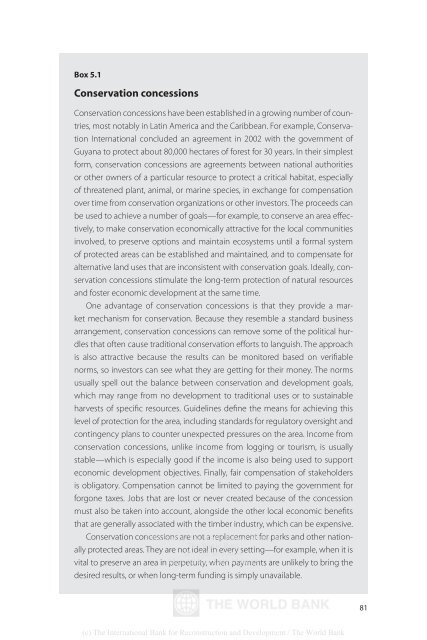The Rainforests of Cameroon - PROFOR
The Rainforests of Cameroon - PROFOR
The Rainforests of Cameroon - PROFOR
- No tags were found...
You also want an ePaper? Increase the reach of your titles
YUMPU automatically turns print PDFs into web optimized ePapers that Google loves.
Box 5.1Conservation concessionsConservation concessions have been established in a growing number <strong>of</strong> countries,most notably in Latin America and the Caribbean. For example, ConservationInternational concluded an agreement in 2002 with the government <strong>of</strong>Guyana to protect about 80,000 hectares <strong>of</strong> forest for 30 years. In their simplestform, conservation concessions are agreements between national authoritiesor other owners <strong>of</strong> a particular resource to protect a critical habitat, especially<strong>of</strong> threatened plant, animal, or marine species, in exchange for compensationover time from conservation organizations or other investors. <strong>The</strong> proceeds canbe used to achieve a number <strong>of</strong> goals—for example, to conserve an area effectively,to make conservation economically attractive for the local communitiesinvolved, to preserve options and maintain ecosystems until a formal system<strong>of</strong> protected areas can be established and maintained, and to compensate foralternative land uses that are inconsistent with conservation goals. Ideally, conservationconcessions stimulate the long-term protection <strong>of</strong> natural resourcesand foster economic development at the same time.One advantage <strong>of</strong> conservation concessions is that they provide a marketmechanism for conservation. Because they resemble a standard businessarrangement, conservation concessions can remove some <strong>of</strong> the political hurdlesthat <strong>of</strong>ten cause traditional conservation efforts to languish. <strong>The</strong> approachis also attractive because the results can be monitored based on verifiablenorms, so investors can see what they are getting for their money. <strong>The</strong> normsusually spell out the balance between conservation and development goals,which may range from no development to traditional uses or to sustainableharvests <strong>of</strong> specific resources. Guidelines define the means for achieving thislevel <strong>of</strong> protection for the area, including standards for regulatory oversight andcontingency plans to counter unexpected pressures on the area. Income fromconservation concessions, unlike income from logging or tourism, is usuallystable—which is especially good if the income is also being used to supporteconomic development objectives. Finally, fair compensation <strong>of</strong> stakeholdersis obligatory. Compensation cannot be limited to paying the government forforgone taxes. Jobs that are lost or never created because <strong>of</strong> the concessionmust also be taken into account, alongside the other local economic benefitsthat are generally associated with the timber industry, which can be expensive.Conservation concessions Delivered by are <strong>The</strong> not World a replacement Bank e-library for parks to: and other nationallyprotected areas. <strong>The</strong>y are not<strong>The</strong> World BankIPideal: 192.86.100.34in every setting—for example, when it isvital to preserve an area in Mon, perpetuity, 09 Nov when 2009 17:06:18 payments are unlikely to bring thedesired results, or when long-term funding is simply unavailable.81(c) <strong>The</strong> International Bank for Reconstruction and Development / <strong>The</strong> World Bank
















